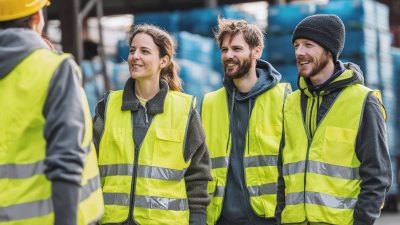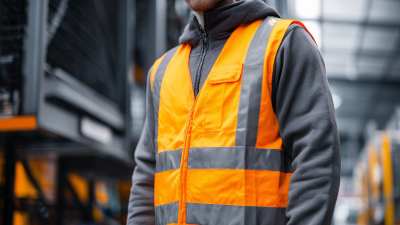When it comes to ensuring safety in hazardous work environments, selecting the right gear is essential, and A safety vest is a critical component. According to the Bureau of Labor Statistics, nearly 5,000 workplace fatalities occur each year in the United States, many due to accidents in low-visibility conditions. Research conducted by the National Institute for Occupational Safety and Health (NIOSH) highlights that high-visibility clothing, particularly safety vests, can significantly reduce the risk of injury by increasing a worker's visibility to others in their surroundings.

These vests come in various colors, materials, and features, designed to meet industry standards such as ANSI/ISEA 107. With a myriad of options available, understanding the key factors—like fabric durability, reflective characteristics, and fit—can help employers and workers choose the appropriate safety vest that maximizes visibility and protection on the job site.
When choosing a safety vest, understanding the visibility standards relevant to various environments is crucial for ensuring worker safety. The American National Standards Institute (ANSI) provides regulations that classify safety vests into different classes based on their reflective materials, color, and design. For instance, Class 1 vests are suitable for low-risk areas while Class 3 vests, which feature high visibility colors and extensive retroreflective strips, are required in high-risk settings such as construction zones or highways. According to a study by the National Institute for Occupational Safety and Health, high-visibility clothing can reduce the risk of accidents by up to 50%, highlighting the importance of selecting the appropriate vest for the environment.
Tips: Always choose vests that meet or exceed the ANSI/ISEA 107-2020 standard for your specific work setting. Consider vests with added features like pockets for tools or IDs, and options made from breathable materials for comfort in different climates.

Further, environmental factors also dictate the choice of safety vests. For example, in dimly lit environments, a vest with increased reflective materials can significantly improve visibility. A report by the Occupational Safety and Health Administration states that well-illuminated work sites with visible safety gear reduce incident rates, proving that proper visibility can be a game changer in protecting workers.
Tips: Regularly inspect your safety vest for wear and tear, and replace it when necessary to maintain visibility standards. Always opt for colors that stand out against the surrounding environment.
When selecting a safety vest for maximum visibility and protection, it's essential to focus on the key features of high-visibility materials. These materials often include fluorescent colors, which enhance daytime visibility, and reflective strips that are crucial for low-light conditions. The combination of these elements allows workers to be seen clearly regardless of the environment, significantly enhancing their safety. For instance, during twilight or night hours, strong reflective materials can catch the light from vehicle headlights, alerting drivers to the presence of workers on or near roadways.

Moreover, the choice of high-visibility apparel should consider compliance with safety standards, which often dictate the minimum requirements for class and visibility ratings. It’s critical for safety vests to meet these regulations to ensure optimal protection. Additionally, garments designed for comfort and breathability can encourage consistent wear among workers, thereby maximizing the intended safety benefits. Effective high-visibility apparel not only protects individuals in hazardous environments but also fosters a culture of safety awareness in industries where such visibility is paramount.
When it comes to choosing safety vests, the effectiveness of reflective patterns plays a critical role in ensuring maximum visibility, especially at nighttime. Research indicates that nearly 80% of traffic accidents occur during dark conditions, underscoring the importance of reflective materials (National Highway Traffic Safety Administration, 2020). Reflective patterns are designed to bounce back light, making wearers more visible to drivers. The choice of pattern can significantly impact recognition distance; for example, vests featuring chevron patterns can enhance visibility by up to 40% compared to standard vertical stripes.
Different reflective materials also present varying levels of effectiveness. According to the American National Standards Institute (ANSI), vests with retroreflective tape are recommended for optimal daytime and nighttime visibility. The placement of these patterns is equally important; research shows that vests with wider bands of reflective material are more effective than those with narrow bands. Moreover, high-visibility lime-yellow is commonly preferred for safety apparel, as studies reveal that this color stands out even in low-light conditions, improving the chances of recognition from a distance. By understanding the nuances of reflective patterns and materials, individuals can make informed choices that enhance safety and visibility in hazardous environments.
| Type of Reflective Pattern | Visibility Level | Best Use Case | Material | Durability |
|---|---|---|---|---|
| Solid Color with Vertical Stripes | Moderate | Construction Sites | Polyester | Medium |
| Mesh Vest with Reflective Tape | High | Traffic Control | Polyester Mesh | Low |
| Fully Reflective | Very High | Emergency Response | Reflective Fabric | High |
| Patterned with Fluorescent Colors | High | Outdoor Jobs | Cotton Blend | Medium |
| Hi-Vis with LED Lights | Very High | Night Operations | Polyester | High |
When selecting a safety vest, it is essential to consider the design features that cater to different genders and size variability to ensure maximum comfort and protection. According to a 2022 report by the Bureau of Labor Statistics, poorly fitting safety gear contributed to approximately 20% of workplace injuries. This statistic highlights the importance of choosing a vest that not only meets visibility standards but also aligns with the wearer's body shape and size. A well-fitted vest can prevent unnecessary accidents that may arise from restricted movement or discomfort.
Moreover, manufacturers are increasingly recognizing the need for gender-specific designs in safety vests. A study by the National Institute for Occupational Safety and Health (NIOSH) revealed that women often face challenges with safety equipment that is predominantly designed for male body types. This design oversight can exacerbate safety risks, as women constitute a growing workforce in sectors like construction and manufacturing. By offering vests tailored to female anatomy, which account for differences in fit and functionality, organizations can enhance both visibility and safety, thus fostering a more inclusive work environment.
When selecting safety vests, it is crucial to consider the specific risks associated with your industry. For construction workers, for example, vests should comply with ANSI/ISEA 107 standards for high visibility and incorporate reflective stripes to enhance visibility in low-light conditions.
Similarly, in roadwork environments, vests must offer bright colors and reflective materials to ensure that workers are seen by passing vehicles, particularly during dusk or night shifts. Utilizing the correct color combination, such as fluorescent yellow or orange, can significantly increase visibility against various backgrounds.
Moreover, understanding your local regulations on safety equipment is essential for compliance and worker safety. Industries like telecommunications or emergency response may have specific requirements for durability and functionality in their vests, such as pockets for tools or technology integration. Choosing a vest that accommodates these needs will not only enhance safety but also improve overall efficiency on the job. Familiarizing yourself with these industry-specific considerations will ensure that the safety vest you select provides maximum protection and meets regulatory requirements, ultimately creating a safer working environment.






